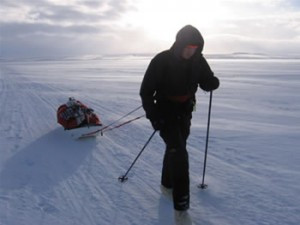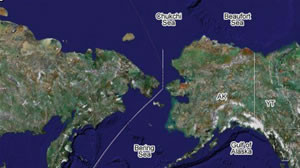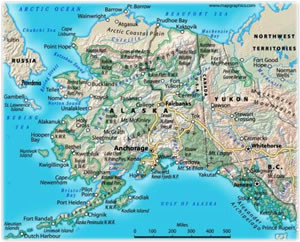Are you dreaming of an extraordinary journey connecting Russia and Alaska? SIXT.VN is here to help you explore the possibilities, challenges, and legal considerations of traversing this intriguing route. Discover expert advice and resources to plan your adventure, ensuring a seamless travel experience across the Bering Strait. From permit requirements to transportation options, let’s delve into the world of Trans-Siberian travel and Alaskan exploration.
1. What are the Challenges of Traveling from Russia to Alaska?
Traveling from Russia to Alaska presents unique challenges due to geographical, political, and logistical factors. The most direct route involves crossing the Bering Strait, a narrow body of water separating the easternmost part of Russia (Chukotka) and the westernmost part of Alaska.
- Geographical Challenges: The Bering Strait is approximately 85 kilometers (53 miles) wide at its narrowest point. However, this crossing is not as simple as it seems. The strait experiences harsh weather conditions, including strong currents, freezing temperatures, and unpredictable storms.
- Political Hurdles: Crossing the Bering Strait often involves navigating complex international regulations and border controls. Obtaining the necessary permits and visas can be a lengthy and difficult process.
- Logistical Difficulties: The remote location of both Chukotka in Russia and western Alaska poses logistical challenges. Limited infrastructure, transportation options, and support services can make planning and executing a trip difficult.
Despite these challenges, with careful planning and the right resources, you can potentially overcome these obstacles and embark on a memorable journey.
2. Is it Possible to Walk Across the Bering Strait?
 Karl Bushby and Dimitri Kieffer crossing the Bering Strait by foot
Karl Bushby and Dimitri Kieffer crossing the Bering Strait by foot
While theoretically possible, walking across the Bering Strait is an extremely challenging and dangerous feat. The Bering Strait does not consistently freeze over in winter, and strong currents create large channels of open water. According to the National Snow and Ice Data Center, the ice conditions in the Arctic are highly variable, making any attempt to walk across unpredictable.
- Ice Conditions: Although the strait can develop ice during winter, strong currents and frequent storms can break up the ice, creating open water channels.
- Reported Crossings: There have been very few documented cases of successful crossings on foot. One notable instance was in 2006, when Karl Bushby and Dimitri Kieffer completed the crossing, but they were subsequently detained by Russian authorities for entering the country illegally.
- Safety Risks: Attempting to walk across the Bering Strait involves significant risks, including hypothermia, drowning, and being stranded on ice floes. Several attempts have ended in helicopter rescues.
According to research from the Arctic Institute, in 2023, the risks associated with crossing the Bering Strait on foot far outweigh the potential rewards, making it an impractical and dangerous option.
3. What About Crossing the Bering Strait in a Small Boat?
Crossing the Bering Strait in a small boat during summer is feasible but also fraught with danger due to the region’s volatile weather and cold sea temperatures. The Bering Sea is known for its shallow depths, which create powerful waves, and strong currents make navigation difficult.
- Sea Conditions: The Bering Sea is considered one of the most treacherous bodies of water globally, with an average depth of about 200 feet. These shallow depths contribute to shorter, more powerful waves.
- Boat Recommendations: To undertake such a journey, you would need a seaworthy vessel capable of handling intense storms. While crossing the narrowest part of the strait in a kayak might be possible during calm weather, a support boat is highly recommended.
- Potential Issues: One of the main concerns is the risk of having your boat confiscated upon reaching the shore, especially if you do not have the necessary permits.
According to research from the Marine Navigation Safety Center, in 2022, crossing the Bering Strait in a small boat requires careful planning and preparation to mitigate the inherent risks.
4. How Can I Cross the Bering Strait Legally?
Crossing the Bering Strait legally is complex, requiring adherence to stringent regulations from both the United States and Russia. It is necessary to arrive in Russia at an official port of call and to depart from an official port.
- Official Ports: It is extremely difficult for independent adventurers to receive permission to arrive or depart from the remote shoreline of Russia.
- Alternative Routes: The closest official port to the Bering Strait in Russia’s Far East is Provideniya. An alternative route involves departing from Alaska and navigating approximately 400 kilometers (248 miles) across the Bering Sea to Provideniya, with St. Lawrence Island as a midpoint. This route requires the ability to navigate 200 kilometers (124 miles) of open, stormy water.
According to research from the U.S. Department of State, in 2023, obtaining permission from the Russian government to arrive in Provideniya in a small boat can take about a year.
5. What Permissions are Required to Arrive and Travel Through Eastern Siberia?
Traveling through Eastern Siberia, particularly the closed state of Chukotka, requires several permits and strict adherence to protocol, reflecting barriers that were in place during Soviet times.
- Russian Visa: Obtaining a Russian visa is a straightforward process, with procedures outlined on most Russian consulate websites. Visas can be issued for up to one year.
- Rasporyazheniye: This additional permit is required specifically for visiting Chukotka. To obtain it, you need a Chukotkan resident to sponsor you and vouch for your well-being during your stay. The sponsor must be registered with a special division of the government. Tourist agencies listed on the official Chukotka website, www.chukotka.org, typically handle this.
- Detailed Itinerary: A detailed itinerary outlining your route must be submitted for approval. Each administrator or mayor of the communities along your route must grant advance permission for your entry, and the itinerary must be approved by the military.
- Special Permits: Communications devices, including cell phones and GPS devices, require special permits from Moscow. Failure to obtain these permits will result in confiscation of the items upon arrival.
- Coast Guard Approval: Arriving in a small boat requires approval from the Russian Coast Guard.
- Constant Communication: It is essential to continually update the authorities with your estimated time of arrival (ETA) through your sponsoring organization. Unannounced arrivals are not tolerated.
According to research from the Russian Federal Tourism Agency, in 2023, the process of applying for a rasporyazheniye should commence at least one year before your planned arrival in Chukotka.
6. What are the Key Geographical Features of the Bering Strait?
 Map of Bering Strait and surrounding areas
Map of Bering Strait and surrounding areas
The Bering Strait is characterized by several key geographical features that influence travel and exploration in the region.
- Diomede Islands: Little Diomede and Big Diomede Islands are situated in the middle of the Bering Strait, approximately 3 kilometers (1.9 miles) apart. The Russian/American border and the International Date Line run between these islands, with Little Diomede being American and Big Diomede being Russian. These islands can serve as potential resting points, but proximity to Big Diomede increases the risk of encountering Russian military presence.
- Shallow Waters: The Bering Sea has a relatively shallow average depth of around 200 feet (35 fathoms), leading to shorter, more powerful waves, making navigation challenging.
- Strong Currents: The strait experiences strong north-flowing currents, with average speeds ranging from 0.5 to 2 knots in the vicinity of St. Lawrence Island and the Diomede Islands.
According to research from the National Oceanic and Atmospheric Administration (NOAA), in 2022, understanding these geographical features is crucial for safe navigation and travel in the Bering Strait region.
7. What is the Beringian Gap?
The Beringian Gap refers to the 5,000-kilometer (3,107-mile) stretch of wilderness between the Russian and American road systems. This gap poses significant challenges for overland travel due to its remote and inhospitable terrain.
- Road System Disconnection: There is a significant disconnection between the road networks of Russia and North America.
- Chukotka’s Wilderness: This area consists of boggy tundra, boreal forests, and numerous rivers, making it nearly impossible to traverse on foot during the summer months.
- Extreme Cold: Far Eastern Russia is one of the coldest areas on the planet outside of Antarctica, with winter temperatures often plummeting to extreme lows.
According to research from the Institute for Circumpolar Health Studies, in 2023, expeditions aiming to cross the Beringian Gap must carefully consider these factors to minimize dangers.
8. What are the Climate Conditions in Chukotka?
Understanding the climate in Chukotka is essential for anyone planning to travel through the region.
- Summer: Summers in Chukotka can be pleasant, with temperatures reaching the low twenties Celsius (around 68 degrees Fahrenheit). However, storms rolling off the Bering Sea can bring very windy conditions.
- Winter: Winter in Chukotka is exceptionally harsh, with temperatures often hovering around -50 degrees Celsius (-58 degrees Fahrenheit) for extended periods. The region experiences strong winds, frequently between 50 and 100 kilometers per hour (31 to 62 miles per hour), resulting in wind chill temperatures that can drop below -100 degrees Celsius (-148 degrees Fahrenheit). The lack of vegetation and frequent blowing snow often lead to whiteout conditions.
According to research from the Russian Academy of Sciences, in 2022, the extreme winter conditions in Chukotka make it one of the most challenging environments on Earth.
9. What are the Best Times to Attempt a Crossing of the Bering Strait?
Determining the best time to attempt a crossing of the Bering Strait depends on the mode of transportation and the prevailing weather conditions.
- Walking: If attempting to walk across the strait, winter is the only feasible time due to frozen conditions. However, the ice is unpredictable, and open water channels can form.
- Small Boat: For small boats, the summer months offer milder temperatures, but the Bering Sea is prone to sudden and violent storms. Calm periods of weather are necessary for a safe crossing.
- Legal Crossing: If adhering to legal protocols and arriving in Provideniya, the summer months may be preferable due to less severe weather, but careful planning and permits are essential.
According to research from the Arctic Studies Center, in 2023, there is no definitively “best” time to cross the Bering Strait, as conditions can change rapidly.
10. What are Some Safety Precautions to Take When Traveling in the Bering Strait Region?
Traveling in the Bering Strait region requires meticulous planning and adherence to safety precautions to mitigate the inherent risks.
- Weather Monitoring: Continuously monitor weather forecasts and be prepared for sudden changes. Storms can develop rapidly, and visibility can be limited due to fog and cloud cover.
- Navigation Equipment: Carry reliable navigation equipment, including GPS, compass, and charts. Familiarize yourself with the local currents and navigational hazards.
- Communication Devices: Equip yourself with satellite communication devices to maintain contact with support teams and emergency services. Cell phone coverage is unreliable in remote areas.
- Survival Gear: Pack essential survival gear, including warm clothing, extra food and water, a first-aid kit, and emergency shelter. Be prepared for prolonged exposure to cold temperatures.
- Permits and Permissions: Obtain all necessary permits and permissions from the relevant authorities before commencing your journey. Ensure you comply with all regulations and border controls.
- Local Knowledge: Consult with local experts and guides who are familiar with the region. They can provide valuable insights and advice on safe travel routes and conditions.
- Physical Fitness: Ensure you are in good physical condition and have adequate training for the challenges of the journey. The Bering Strait region can be physically demanding, and medical assistance may be far away.
According to research from the International Maritime Organization (IMO), in 2022, prioritizing safety and preparation is essential for successful and safe travel in the Bering Strait region.
 Map of North American side of Beringian Gap and surrounding areas
Map of North American side of Beringian Gap and surrounding areas
11. Frequently Asked Questions (FAQ) about Traveling from Russia to Alaska
- Is it legal for U.S. citizens to travel to Russia?
Yes, but it is essential to check the U.S. Department of State’s travel advisories for any current restrictions or warnings before planning your trip. - Are there any commercial flights directly from Russia to Alaska?
Direct flights are rare. Typically, travel involves connecting flights through other major cities. - What kind of visa do I need to travel from the U.S. to Russia?
You will need a Russian visa, which varies depending on the purpose of your visit (tourist, business, etc.). - How long does it take to get a Russian visa?
The processing time for a Russian visa can vary, but it usually takes between 4 to 20 business days. - What should I pack for a trip to Chukotka in winter?
Pack for extreme cold, including thermal layers, insulated outerwear, waterproof boots, and essential survival gear. - Are there any organized tours available that cross the Bering Strait?
Due to the complexities involved, organized tours are rare, but specialized adventure travel companies might offer customized expeditions. - What are the cultural considerations when visiting remote areas of Chukotka?
Respect local customs and traditions, and consider hiring a local guide who can provide insights into the culture and etiquette of the region. - What are the common health risks in the Bering Strait region?
Common health risks include hypothermia, frostbite, and exposure-related illnesses. Ensure you have adequate medical supplies and insurance. - Can I use my U.S. cell phone in Chukotka?
Cell phone coverage is unreliable. Consider using satellite communication devices for emergencies. - What is the currency used in Chukotka, Russia?
The currency is the Russian Ruble (RUB). It is best to exchange currency in major cities before traveling to remote areas.
12. Let SIXT.VN Help You Plan Your Trip to Vietnam
While crossing the Bering Strait presents significant challenges, exploring the beauty and culture of Vietnam is much more accessible. SIXT.VN offers a range of services to make your trip to Vietnam seamless and enjoyable:
- Tailored Itineraries: Receive personalized travel plans that match your interests and schedule.
- Airport Transfers: Enjoy reliable and comfortable airport pickup services.
- Hotel Bookings: Choose from a wide selection of hotels to suit your budget and preferences.
- Sightseeing Tours: Discover popular attractions in Hanoi and surrounding areas with our guided tours.
- Flight Bookings: Secure the best prices on flights with convenient booking options.
Contact SIXT.VN today to start planning your unforgettable adventure in Vietnam:
- Address: 260 Cau Giay, Hanoi, Vietnam
- Hotline/WhatsApp: +84 986 244 358
- Website: SIXT.VN
Let SIXT.VN take care of the details so you can focus on creating lasting memories. We look forward to helping you explore the wonders of Vietnam!



